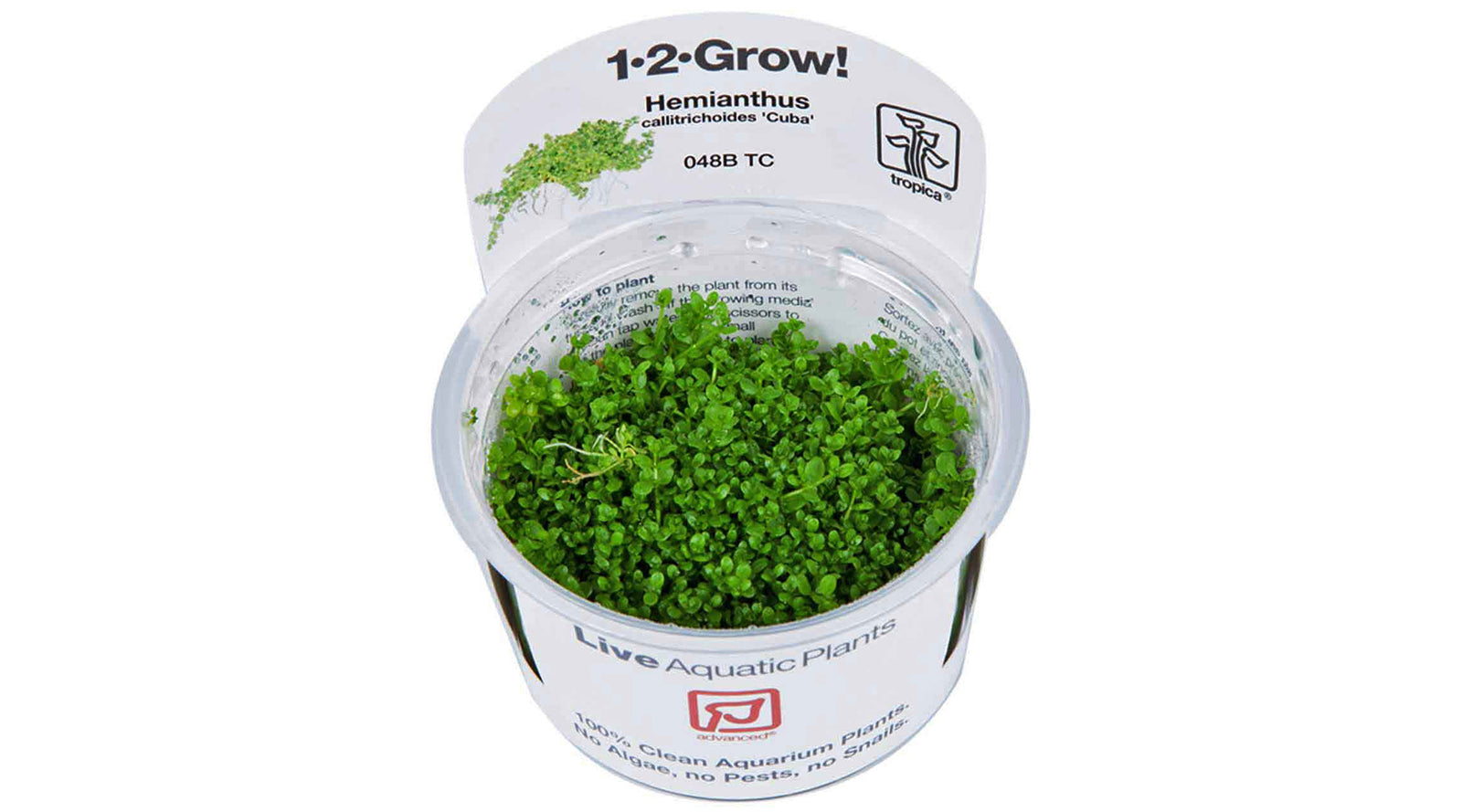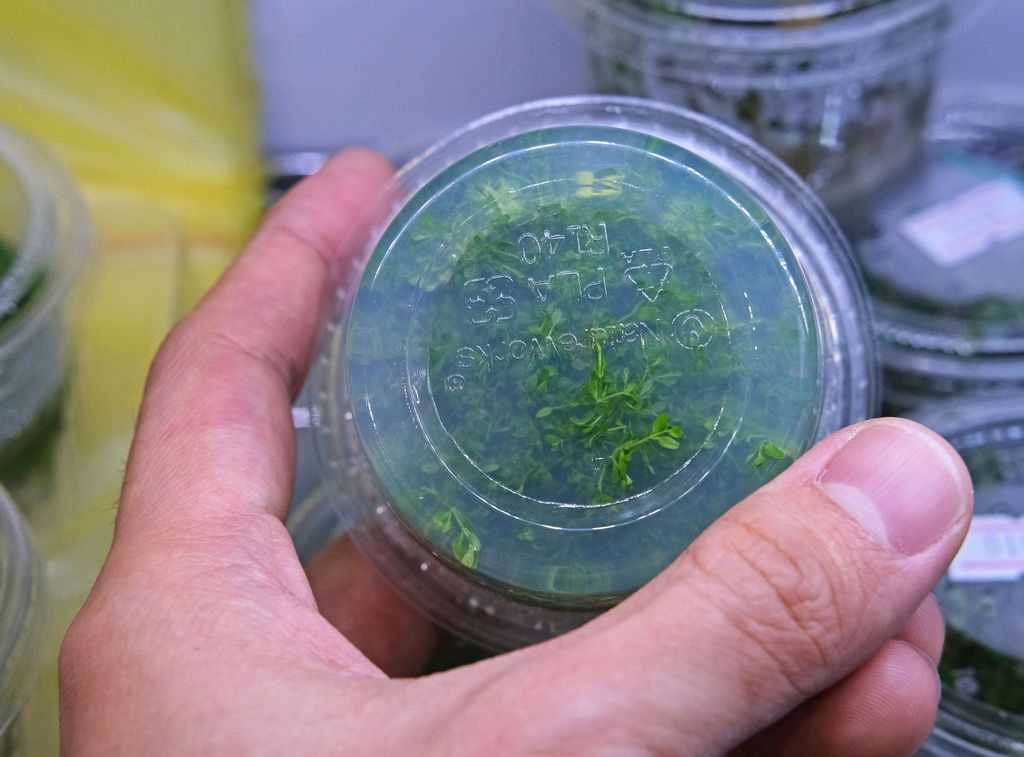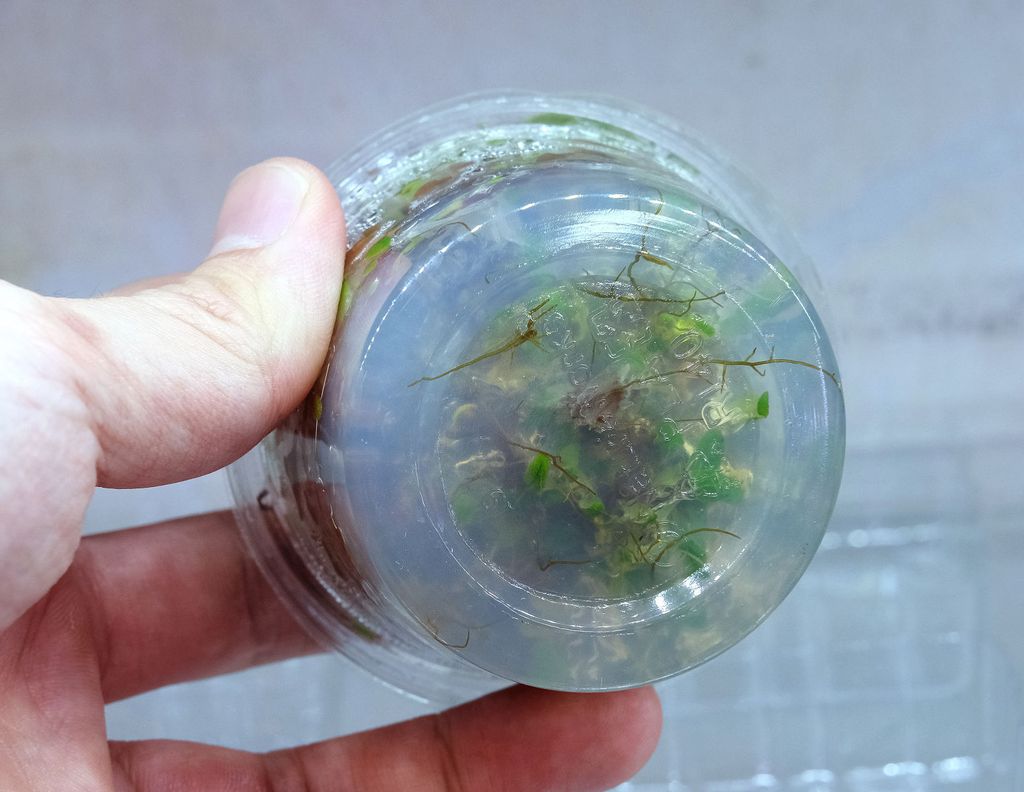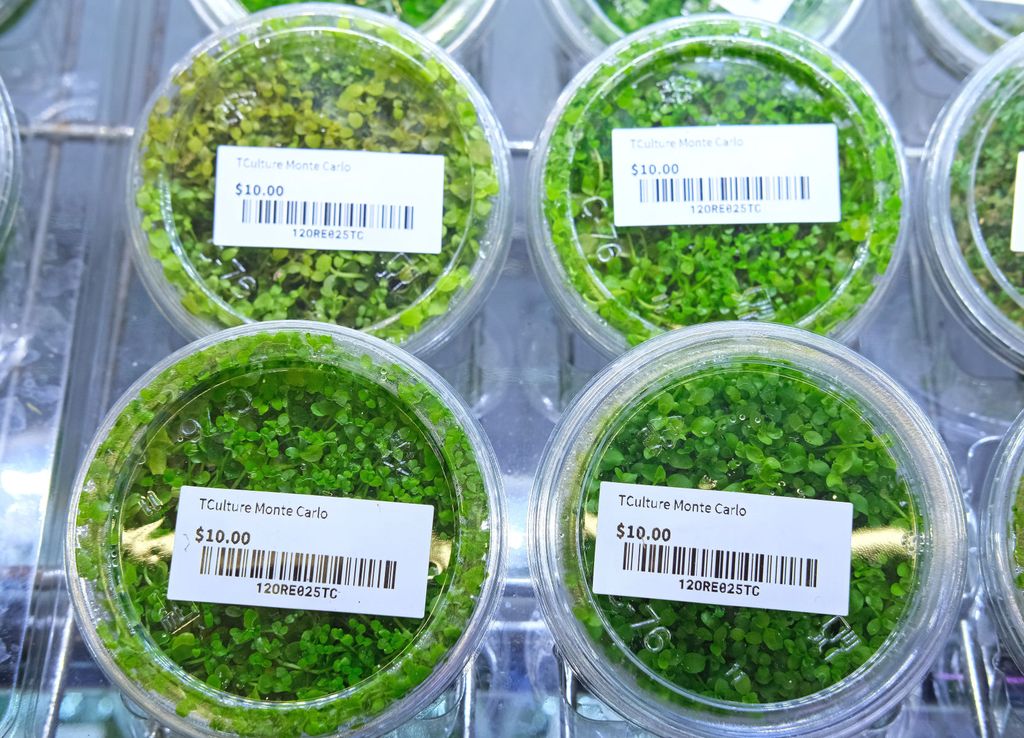
Introduction
Tissue culture plants are grown in a laboratory under sterile conditions; plant cells are propagated on a culture medium and produces exact copies of a plant without the need to go through seed production or pollination. It is especially useful for producing a large number of plants for species that are difficult to grow or propagate by other means. Plant tissue culture relies on the fact that many plant cells have the ability to regenerate a whole plant if nestled in a suitable media and environment. You can read more in detail about the process here.
Tissue culture aquatic plants have been on the market a long time by now, and their main advantages to the consumer is that they come free from pest and algae, and actually offer tremendous bang for the buck – if successfully grown. Tissue culture tubs come packed with small plantlets, each capable of growing to a full sized plant, so you get a lot of plants for a low price; its almost like buying a packet of seeds. However, these plantlets are more delicate than larger sized plants and thus many hobbyists can fail with them for reasons we will explore below.
If a tissue culture cup comes without pictures, it can be quite hard for beginners who are unfamiliar with the names of aquatic plants to discern what the full grown plant will look like. Many red plants can be green when grown in tissue culture format; for some species, their leaf shapes will be different when they are fully grown as well.
This cup of Rotala H’ra will grow into a lovely reddish stem plant (left below)
A single cup of tissue culture dwarf hair grass was all it took to carpet this tank fully in 6 weeks. The plantlets grow and spread fast under the right growth conditions.
As the many plantlets transition seamlessly into submerged forms adapted to your tank environment, you are not left with the need to manage old emersed growth from a farm grown plant, or growth from submerged forms adapted to another grower’s tank.
Pros
- A lot of plants per tub, making it very economical
- Pest and algae free
- Species profile tend to be more standardized
- Easier to transport/store for vendors
Cons
- Less robust than large sized plants
- Conversion rates dependent on aquarist skill
- Newer aquarists may find it difficult to tell freshness of sample
For folks worried about pests and algae, or have difficultly finding quality larger sized plants, tissue culture can be a good choice.
How to choose tissue culture tubs
As the number of tissue culture aquatic plant species grow, so do the number of farms that try their hand at tissue culture. Some times the quality of tissue culture can be quite obvious – like some brands will visibly have more plants per cup. However, the brand of the tissue culture is not the only marker of quality. Freshness is a major factor. Plants in tissue culture tubs can last a long time (many weeks if chilled), however, depending on where they were produced, the samples may have already gone through a long transport journey to the shop. If the plants are left sitting on the shelf too long, it tends to deteriorate and chances of transitioning smoothly in the tank are diminished. Fresher, more robustly grown tissue culture plants transit more easily after being planted into the tank.
Rather than just going by which brand is most familiar, hobbyists should also consider their purchasing decision based on the quality of tissue culture present. A branded tissue culture product left browning on the shelf because it has been sitting there too long has far less chances of transiting smoothly into the tank compared to a fresh batch. Quality matters a lot when choosing tissue culture !
Here are a few points to spot a fresh cup of tissue culture:
A cup that has been sitting around too long:
- Gel media is very dark or brown
- Brownish roots, root zone is over-crowded and packed with roots
- Plants are yellowing – signs of yellow or brown spots on the culture
- Obvious signs of old deteriorating leaves
- White fungus/mold
When seen from the bottom, the gel media here has darkened considerably – some roots are blackened.
White patches can indicate mold/fungus. Browning/yellowing leaves are apparently.
Uneven coloration, sparsely grown in plants, discolored gel media – these are all signs that this tissue culture cup has been sitting around far too long on the shelf. Though there is still a hint of green on the leaves, chances of success are greatly diminished. Some super hardy species may still be saved from such tissue culture cups, but generally hobbyists should avoid tissue culture in such a state.
Signs that a tissue culture cup is relatively fresh:
- Gel media is pale white or transparent
- White roots, root zone is not over crowded
- Plant leaves are uniformly colored – green plants are uniformly green without any sign of yellowing or browning
- No old leaves are present in cup
- No sign of fungus/mold in the cup
Gel media is whitish without discoloration.
Leaves are uniformly green with no sign of yellowing.
No substantial development of brownish roots, whitish media.
Leaves are uniformly green with no yellowing, gel media has not browned.
Some practical examples:
On the surface, the tissue culture cup looks kinda alright. Those with sharper eyes will spot a few browning leaves. The cup is also slightly over-crowded; which means that the plants have been sitting and growing on the shelf for awhile.
The side view shows that the media has browned considerably, and that the plants have been sitting long enough that additional shoots have grown stacked on top of older plants. The plants however, look generally green.
The roots are not bright white, but yellowish. Cup is starting to look over-crowded at the rootzone.
All signs show that this tissue culture tub has been sitting around for quite a while. It is not a fresh sample, but neither is it too far gone yet. In the hands of an expert grower with excellent growth parameters in the tank, the success rates of acclimatising such a sample into the tank is high; you might lose the few samples with browning leaves. However, for folks with less optimized setups, a fresher sample will give higher conversion rates. Success rates are also species dependent. This tissue culture cup contains Marsilea crenata, which is a very resilient plant – planting a less fresh sample still has good success rates. For more delicate species, you might want to look for the freshest sample possible.
In this cup, the plants look very uniformly green, there is no sign of yellowing leaves at all. Some of the stems look to have grown slightly, hitting the top cap of the container.
A peak at the bottom shows a mass of white roots. While it seems like the plants in this cup has had time to grown in a bit. The plants look very healthy overall. This tissue culture cup gets top grade for freshness though it seems as though the plants have had some time to grow in the cup.
At first glance, this cup seems alright – there are a few brownish leaves but most of the cup seems a fresh green.
The bottom gel does not look brownish, however, you can spot some browning of the plant roots and leaves.
The side view affirms that the browning is significant, and possibly affecting deeper layers in the cup. Despite the tub looking not too old from the bottom view, the plants are not in good condition in this sample. Be wary of cups that have green on the top surface, where new growth is still healthy, but contain mostly browning plants in the middle & bottom – in such a sample, one could end up discarding up to 80% of the tissue culture cup.
Which one of these 4 cups of Monte carlo is in the best state? If you have been following the guide so far it should be obvious by now. Top left has yellowing, top right and bottom left looks a tad over-crowded (notice how the leaves fill the top edges of the cup). The bottom right cup has the greenest, most well formed leaves with no overcrowding.
The side view shows more clearly the over-crowding of the top left, top right and bottom left tubs.
The bottom view is consistent with what we see from the top and sides. The bottom right sample is the one in best shape and color. The rest are more overcrowded, with the top left one showing obvious yellowing. In this example, I would definitely avoid the top left tub; even if your tank has good growth parameters you will face more melting issues due to the quality of the tissue culture. I think that the top right and bottom left tubs are usable, but not optimal. The bottom right cup has the best success rates.
How to acclimatise tissue culture plants to tank conditions
There are plenty of poor examples of how these plants are handled on YouTube and other videos as aquarists that do such videos want to get the entire setup done in a short time. Tissue culture in general (especially for exotic or more picky species) – does best in a cycled tank, with a substrate that has time to matured. They should not be planted fresh in a new setup on day 1. This factor alone is why many aquarists have melting plants.
If you want to grow more exotic, picky species, such as Hygrophila sp. Chai from tissue culture – planting them in a matured, clean tank with low organic waste levels maximizes success. A single cup of tissue culture Cryptocoryne flamingo can produce more than 15 plants – a real steal if you handle them correctly.
After washing off the gel media,for plants that have come in clumps, separating them into individual plantlets or smaller clumps (for carpet plants) maximizes success rates. Stem plants that come tangled in a common root mass should be divided carefully and planted individually or in very small bunches. Separating the plants into individual plantlets give each plant more room, flow and light to grow.
Planting large thumb sized clumps of carpeting plants look good on video, but is terrible practice – larger clumps tend to float at the slightest disturbance as well. For carpets, planting small pieces across a large area allows the small pieces to spread – reducing time needed to carpet the area. The video below shows 6 days of growth from planting tissue culture plants.
CO2 and nutrient availability are also tremendously important for plants to acclimatize well to tank conditions. Aim for at least a 1pH drop when tuning CO2. Liquid fertilizer should be added on day one – once the plants are planted. This is because freshly planted plants have not yet developed their root system and cannot draw nutrients from the substrate. However, they can intake nutrients directly from the water column through their leaves.
A summary of key success factors
- Tune your CO2 levels well – aim for at least a 1 pH drop
- Start dosing liquid fertilizer on the day that the plants are planted; read more why here
- Cycle your tank before hand
- Maintain low organic waste levels at substrate zone
- Separate plants into as small clumps as possible when planting
- Do not squish the delicate plants when handling them – use forceceps
Caution when buying exotic species
For some exotic species, some farms produce batches of under-developed tissue cultures where the success rates of converting them to the tank environment is low (near zero). Shops will not filter out such stock on their own; unfortunately this usually leaves hobbyists holding the bag. Hobbyists should be extra observant when buying tissue cultures of exotic species. Generally, look for larger sized, well developed plants in such cases. (pictures will be added if possible at a later date). The usual markers for freshness mentioned earlier in this article still applies.
























